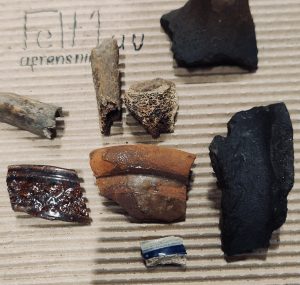The Lost Manor, Found – The 2025 Excavation of Højby.
By Anna Boas-Dykes and Rainer Atzbach
The lost manor of Højby close to the village Gosmer, south of Aarhus in Central Jutland, Denmark, has long been a site of interest for archaeologists, historians, and metal detectorists alike. Historical sources point to the site being in use from 1338 to 1662, with the bishop of Aarhus, as well as nobility such as the Rosenkrantz family, being among its owners. There has also been a wealth of metal, ceramic, bone, and brick finds over the years, which have indicated a possible layout of the manor. More information about the history of the site can be accessed in a former Encounter Newsletter (https://encounter.network/news/6034-2/).
On the second of June 2025, first-year archaeology students from Aarhus University started digging on this site during their training excavation until 20 June 2025. Six trenches have been dug based on the distribution of brick fragments, cadastral maps and magnetometry. The latter is a non-destructive archaeological method which records changes in the Earth’s magnetic field, caused by archaeological contexts hidden in the soil. Since red bricks contain trace amounts of iron, they showed up on a magnetometric scan, suggesting a possible outline of structures on the site.
Already after the initial archaeological site cleaning of the surfaces in these trenches, the definitive location of Højby manor was able to be determined. Figure 1 shows a rendering of these trenches superimposed onto a cadastral map of Højby from 1797. In the trench marked with ‘2’, large postholes in intervals of approximately 1.2 meters have been identified. The interval is characteristic of mediaeval Danish building style; however, the postholes themselves have a diameter larger than the norm for house construction. These factors, as well as the overlap of the postholes with a cadastral boundary on the map, have led to the preliminary conclusion that this could be what remains of a defensive palisade on the site.
Furthermore, high concentrations of brick fragments were found in the southernmost part of trenches 2 and 3, as well as the western part of trench 1. These are remnants of the western and southern moats surrounding the complex. The moats were also visible in the magnetometric scans of the site, as highlighted in Figure 2. In the coming days, these trenches may be expanded to uncover the moats further. As more of the layout is revealed, it is important to note that the ownership of this land has changed multiple times over the years, which could account for any overlap in structures. Additionally, based on the size of the moat, the complex must have originated as more of a castle or keep, evolving into a manor over time.
Following these initial observations and the registration of various contexts on site, students began the process of excavating the contexts and recording finds. A myriad of fascinating artefacts and ecofacts have reached the finds table. Pottery shards range from the Iron Age to the Renaissance. Equine remains have also been found, as well as hooks, nails, slag and other scraps of iron. The wealth and diversity of finds reflect the long period of habitation recorded in historical sources. Some artefacts show that this field has been in use before the 1300s, for instance, shards of “Østersøkeramik” have been found, which is a type of pottery dating from the 11th to the 13th century. Some of these findings can be seen in Figure 3 below. In the coming weeks, the excavation will continue, and the students involved anticipate literally and figuratively uncovering the history of “Højby Voldsted.”
Contact information
Anna Boas-Dykes
Rainer Atzbach
Dep. Archaeology and Heritage Studies
Aarhus University


